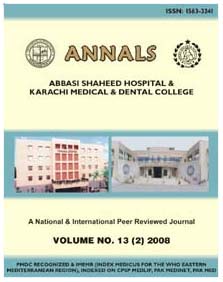
| |
| Home |
| Editorial Staff |
| Instruction to Authors |
| Journal-Issues |
| Policy |
| Copyright |
| COMMON MENSTRUAL DISORDERS IN ADOLESCENTS
RABIKA LIAQAT ALI KHOJA,FARIHA JAMAL,MEDIHA, SARAH AHMED SIDDIQUI, MAHWISH MOIN JAH, 1 FARAH ASAD MANSURI ABSTRACT Objective: To assess the knowledge of adolescent females about menstruation, prior to their menarche. To determine the frequency of common menstrual disorders. To determine the number of adolescents taking medical treatment for menstrual disorders. To assess the awareness of adolescent females about the menstrual disorders they are suffering from. Method: It was a descriptive cross sectional study. The study was carried out in a teaching hospital, various schools and colleges and a slum area of North Nazimabad, Karachi. The study included 150 adolescent females on the basis of non probability purposive sampling. A previously prepared questionnaire was filled which included demographical profile, details about the participantís menstrual history and the treatment taken, if any, for the disorders they were suffering from. Result: One hundred and fifty adolescent females participated in our research aged 11 to 19. The girls were non-married, not pregnant and free of co-morbidities. Out of total, 61% participants had menstrual disorders. Out of which 58.6% girls had dysmenorrhea, 12.7% had menorrhagia, 4.7% girls had oligomenorrhea and 2% girls had amenorrhea. 19.3% girls had such severe dysmenorrhea that it affected their school and social life. Only 38% of the suffering girls were aware that they had a menstrual problem. 15.3% of the participants were taking medication for their menstrual problem. 86% girls had prior knowledge of menstrual cycles before menarche. Most of them were taught about normal menstruation by their mothers. So they considered it to be a normal physiological phenomenon. Conclusion: A majority of adolescents in Pakistani society face menstrual disorders after their menarche. There is also a need to teach people about treatment at the community level so the girls can realize and overcome these problems befre the disorders can go into complications like infertility or uterine cancers. Keywords: menarche, dysmenorrhea, oligomenorrhea, amenorrhea, menorrhagia
|
For Full text contact to:
|
|
Final Year MBBS Students
|

Copyright © 2009 Abbbas Shaheed Hospital and Karachi Medical & Dental College.
All rights reserved.
Designed & Developed by: Creative Designers